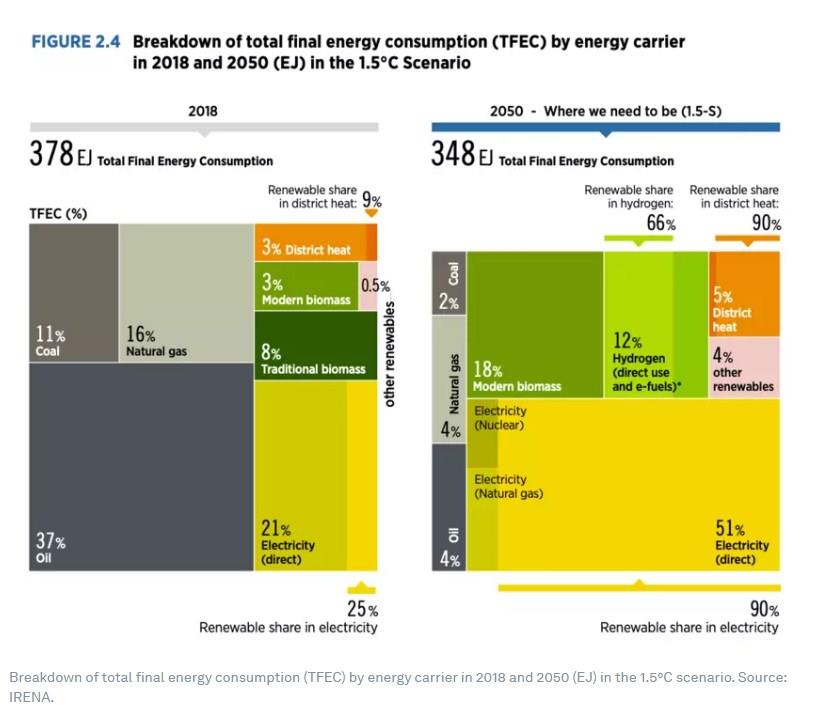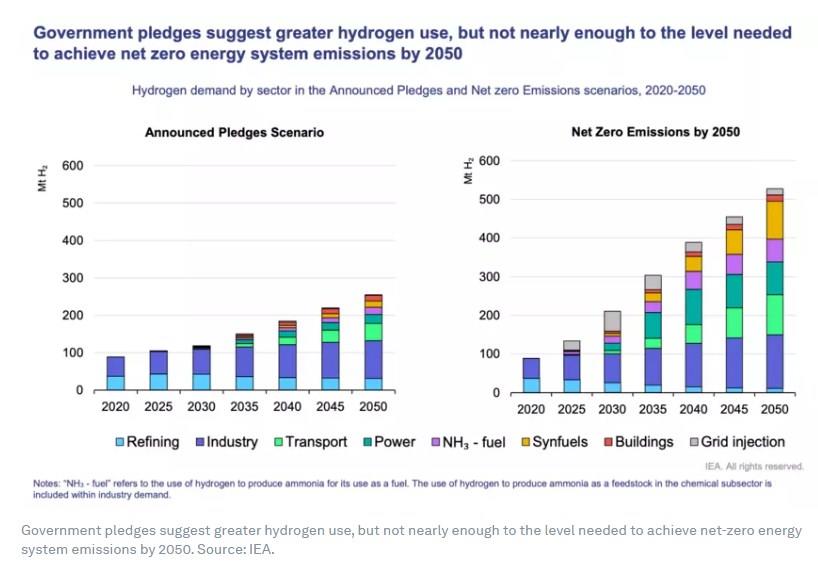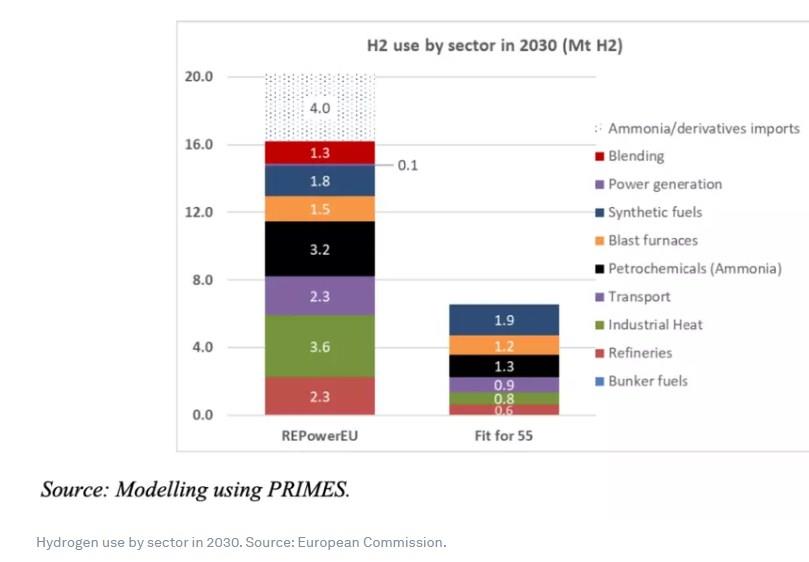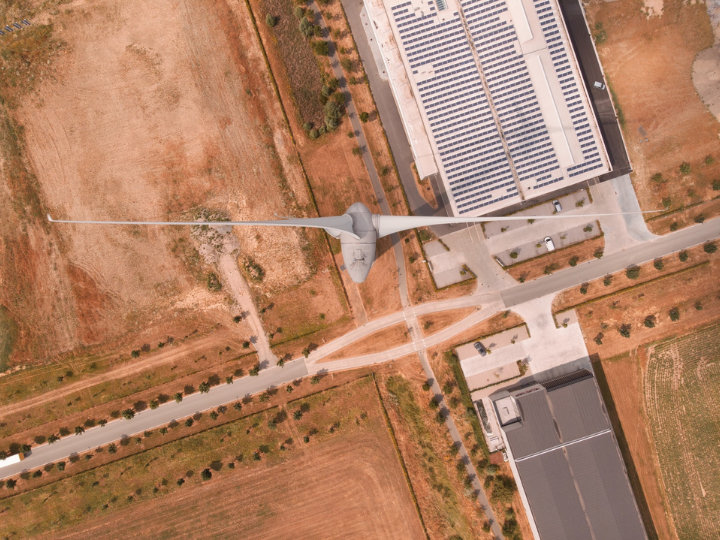by Noam Boussidan, Jorgen Sandstrom and Melissa Stark*
Electrification is the number one energy vector for the energy transition, forecast to account for over 50% of total final energy consumption by 2050 in a 1.5°C scenario. However, a decarbonized energy system requires both a huge scale-up in electrification as well as low carbon fuels. In fact, they are not only needed for instances where electrification is challenging or not possible, but also to complement an increasingly intermittent energy system through long-duration storage, flexibility and balancing.
Enter clean hydrogen
The International Renewable Energy Agency’s (IRENA) 2021 World Energy Transitions Outlook estimates that hydrogen and its derivatives will account for 12% of final energy consumption by 2050, with two-thirds coming from green hydrogen (made with clean electricity) and one-third from blue hydrogen (made from fossil fuels and using carbon capture).

Where are we today?
In 2020, the world produced around 90 million tonnes (Mt) of hydrogen, generating 900Mt of CO2, around twice the UK’s 2020 emissions. The vast majority of this hydrogen is used by the refining and chemicals industries. If we were to replace our existing consumption of grey hydrogen (made with fossil fuels and no carbon capture) with green hydrogen, we would require a lot of extra clean electricity (double the amount of renewable electricity that had been installed by 2020 globally).
This increase would only replace our existing grey hydrogen consumption and does not take into account any emerging uses. For example, in hard-to-abate sectors such as steel and heavy mobility or even fuel for ships and planes.
How much more hydrogen will we need and by when?
The IEA estimates that we need 530Mt of hydrogen to reach a net-zero scenario in 2050. That is roughly a six-fold increase from today’s hydrogen production.

In addition to the challenge of this huge scale-up, the global energy system is experiencing major disruptions caused by geopolitical tensions, the war in Ukraine and the tightening of oil and gas markets. The impact of this can be seen in hydrogen markets across the world. For example, with Europe increasing its 2030 renewable hydrogen targets from ~5Mt to 20Mt in a move to replace reliance on Russian gas as laid out in the REPowerEU strategy.

The challenge, however, is non-negotiable if we are to hit our climate goals in line with the Paris Agreement 1.5C scenario and IPCC recommendations.
COP26 showcased the global momentum for hydrogen as critical in the shift from fossil fuels. New commitments, updates in strategy and project announcements have become an almost daily occurrence. To highlight some numbers:
-Approximately 40 national hydrogen strategies have been released or are in development.
-Over 500 projects have been announced globally worth more than $500 billion in investment.
-Over $130 trillion of private capital was committed to transform the economy to a net-zero future by the Glasgow Financial Alliance for Net-Zero (GFANZ).
These numbers demonstrate that the momentum for clean hydrogen is growing quickly, and there is pressure for the most abundant element on earth to deliver on its role in the energy transition.
The Forum approach – bringing together public and private stakeholders to accelerate clean hydrogen uptake globally
Despite the impressive headlines, significant effort is still required to move from announcement to action and pledges to projects. For example, the Financial Times recently reported that investors in Australia lack confidence in hydrogen projects, with the $188 billon pipeline of projects yet to be translated into a single molecule of hydrogen being sold.
Similarly, during the recent World Hydrogen Summit in Rotterdam, Daryl Wilson, Executive Director of the CEO-led Hydrogen Council, stated that "the pipeline of hydrogen projects globally exceeds 500 projects valued at more than $500bn of investment. In Europe there are 328 projects, yet barely more than 5% have made final investment decision. Crossing the investment decision line requires the confidence that policy will support both demand and supply for the investment horizon of several decades. The public and private sectors need to come together and establish the conditions to take this critical step urgently."
How is the World Economic Forum accelerating action?
It is on this very topic that the World Economic Forum’s Accelerating Clean Hydrogen Initiative is working. Together with IRENA and supported by Accenture, we launched the Enabling Measures Roadmaps for Green Hydrogen at COP26.
The Roadmaps, initially focused on Europe and Japan, detail the suite of solutions required to remove key barriers and boost the hydrogen economy towards a fully realised net-zero economy. They are a tool to enhance public-private dialogue and turn industry recommendations into concrete policy measures, propelling action to create the necessary environment to get projects off the ground.
In the forthcoming year, we aim to expand our scope to cover further geographies, focusing on regions with high export potential such as Latin America and the Middle East, with China and India also being actively scoped.
In addition, we are very excited to launch the Clean Hydrogen Project Accelerator at the Forum’s annual meeting in Davos this week. We will work directly with projects and their developers to remove specific barriers and expedite the pathway from announcement, through FID and into operation.
This acceleration programme will drive progress at the project level to support cost reduction, innovation and bankability. The aim is to build ties between project developers, investors and policymakers, and to accelerate the time between project announcement and FID. In the medium term, we will scale this process by developing a toolkit with our member organizations and partners, sharing practical learning globally.
This is a hugely exciting and challenging time for the clean hydrogen economy. Bringing together the full suite of stakeholders that can make it real and overcoming the hype is more necessary than ever. We will be doing just that in Davos, and we will make sure that these voices, driving powerful change across energy, industry and mobility systems, are heard.
*Platform Curator, Energy, Materials Infrastructure Platform, World Economic Forum and Head of Energy, Materials, Infrastructure Programme, Industrial Transformation, World Economic Forum and Head, Global Renewables& Energy Transition, Accenture
**first published in: www.weforum.org




 By: N. Peter Kramer
By: N. Peter Kramer

